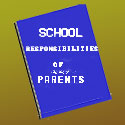Costs to parents at a girls' grammar school in the 1950s

Even though some rationing and austerity was still in place in the 1950s, the Government invested in the future through its children. This page describes the support that it gave to grammar school children in terms of what was supplied to them free of charge. There were still some costs to parents which this page also describes.
____
By the webmaster, based on personal recollections from Copthall School with discussions and contributions from former students
With hindsight it amazes me how much was free at my girls' grammar school in the 1950s. This was a time of austerity following the Second World War and rationing was still in force for some things. Yet the Government saw fit to invest in what it regarded as the brightest of its younger generation - those who had passed the 11-plus exam, irrespective of their class or background.
My grammar school in the 1950s did so much for us that we didn't have to pay for. Only now, in much later life, do I really appreciate it.
What was supplied free
All our paper was supplied by the school, free of charge.
We had a 'rough book' each, which as its name implies was for rough work and which was of a poor quality paper in a rough blue cover.
The exercise books that we did our classwork and homework in, though, were of reasonably good quality paper. I suspect we were lucky as a flagship grammar school, because someone from a grammar school from the other side of London told me that they were always short of paper and had to make do with whatever scraps they could find. Nevertheless, we always had to prove that we needed a new exercise book, as explained in the following box.
The stationery cupboard
contributed by Christine Tolton (formerly Christine Culley)
The Stationery Cupboard was, I seem to remember, in one of the corners upstairs. When we needed a new exercise book, the old one had to be scrutinised to make sure there was no space left in it. I think a teacher was in charge of this - could have been a prefect - but I seem to have a picture of Mrs Howle carefully going through my 'full up' rough book! She begrudgingly let me have a new one!
We didn't have to buy our text books, either. There was no shortage of them and we didn't have to share. These books were of course on loan, so we did have to return them or pay for replacements at the end of the school year. They didn't seem well-worn, probably because each new recipient was required to cover them in fresh brown paper - which was checked by the class teacher.
Also, girls who lived more than three miles away - which included me and most of my friends - were supplied with a free public bus pass to get to and from school. It was handed out in class at the beginning of every term. In practice, though, I seldom used it because I preferred the freedom of cycling rather than having to queue up at a bus stop. My bus was a small single deck one because it had to pass under a low bridge, and this meant that it could not cope with the influx of large numbers of girls at home time. On the few occasions that I used it, it was quite normal to have to queue in the cold for several buses to arrive before being allowed on. Actually, though, I enjoyed the cycling, and I am sure it was good for me.
I seem to remember that ink was supplied by the school because there was an inkwell monitor who had the task of filling the inkwells in the desks, but by then everyone seemed to have their own fountain pens.
What parents had to pay for or buy
Parents did have to pay for our school uniform, but they would have had to clothe us anyway, albeit possibly rather more cheaply.
Parents also paid for our school dinners. Awful as these were, they were at least off-ration and without them, our parents would have had to feed us on the meagre rations from our ration books.
Parents also had to supply our pens, pencils, rubbers, rulers and geometry sets.

Rulers were wooden, and they got very messy as names had to be scratched onto them. Plastic rulers were beginning to come in but were not common.

My grandfather's ruler was made of bone of some sort. Somewhat surprisingly, in hindsight, the protractors and setsquares that we bought for school came in some sort of transparent plastic. (My grandfather's, though, were wooden.)

We supplied our own pencils, known as lead pencils, even though the 'lead' was actually graphite in wood. They had to be sharpened regularly with a knife or special pencil sharpener as the lead wore down, leaving a rough wooden edge.
There were charity drives to which we, actually our parents, were expected to contribute, but the cost was nominal.
If you were at Copthall around this time, you will probably like the pages on life in the 1940s and 50s - see the above ALL TOPICS link. Information and photos are always welcome.
| sources | webmaster | contact |
Text and images are copyright
If you can add anything to this page or provide a photo, please contact me.



